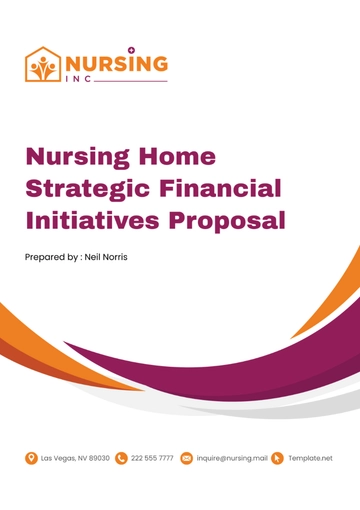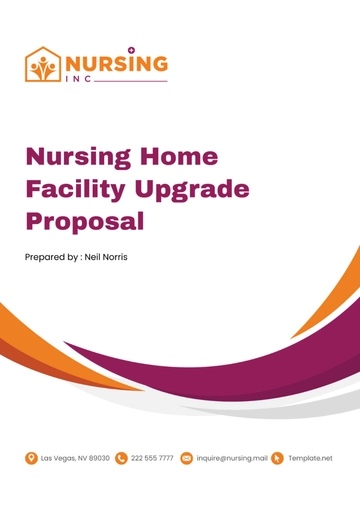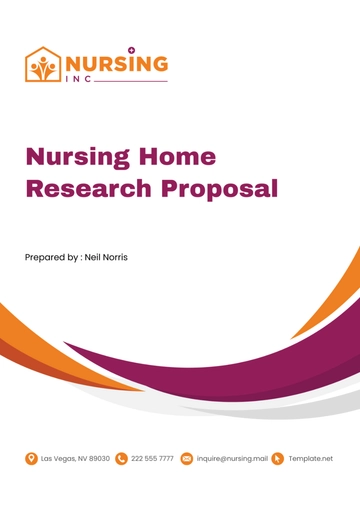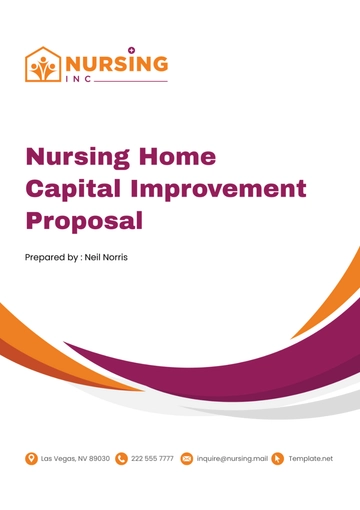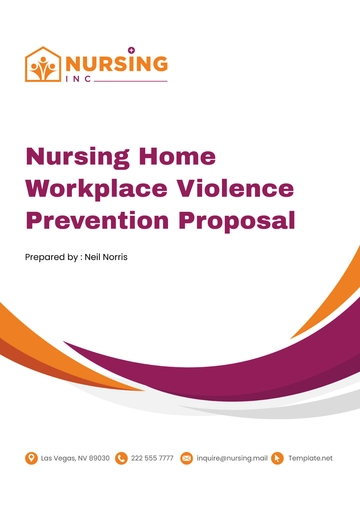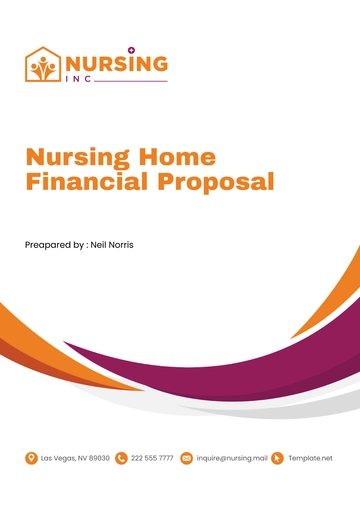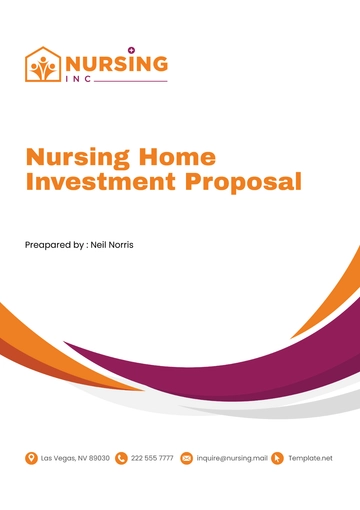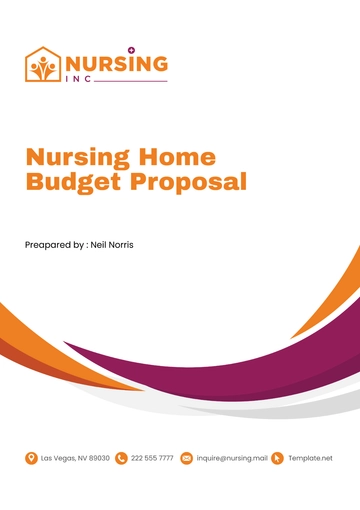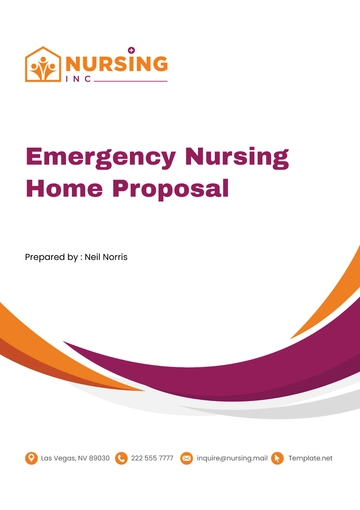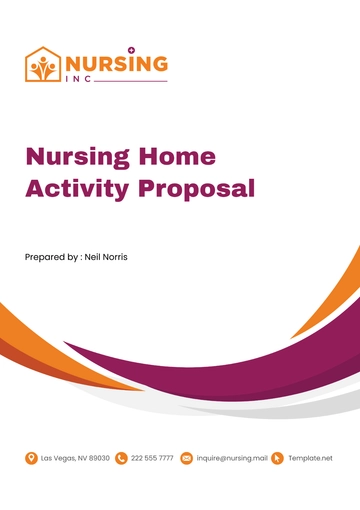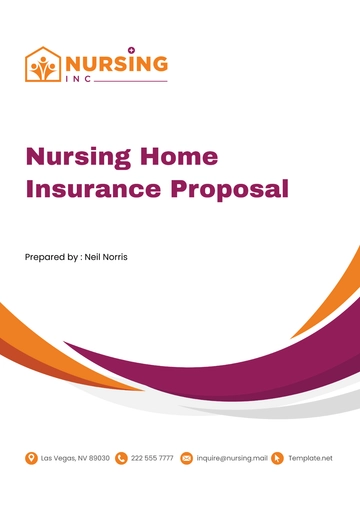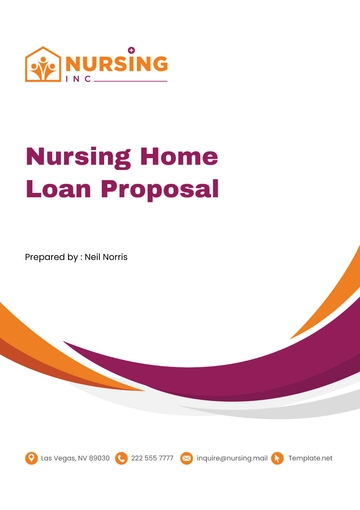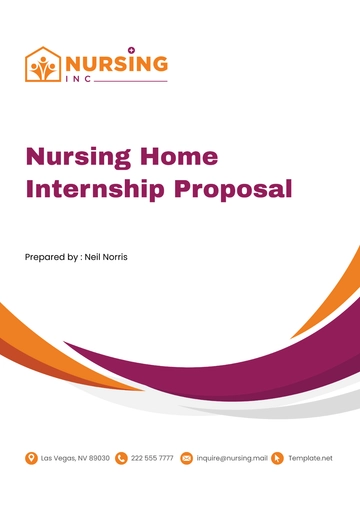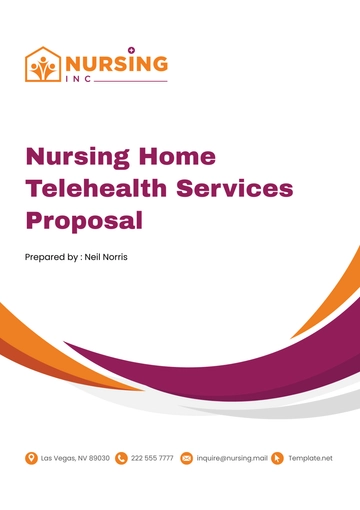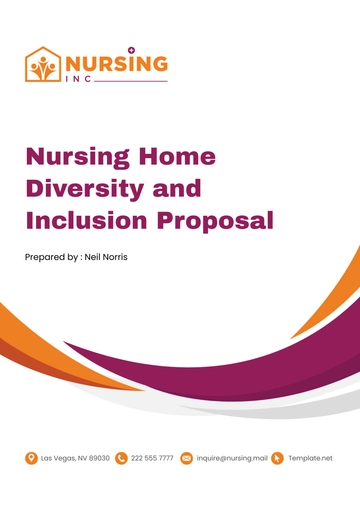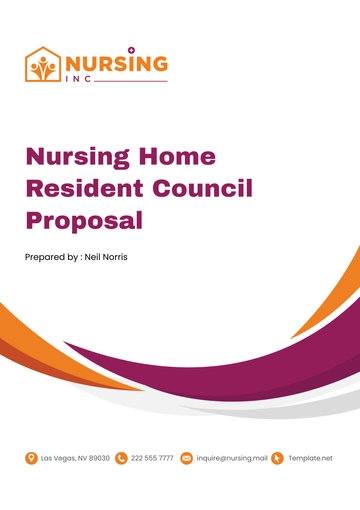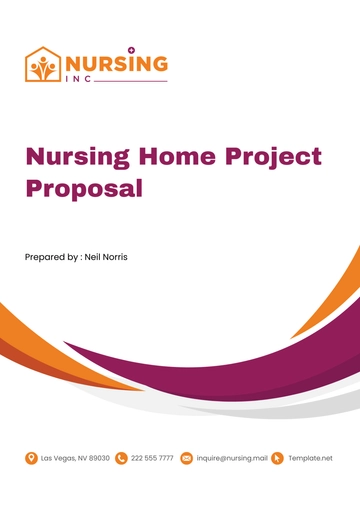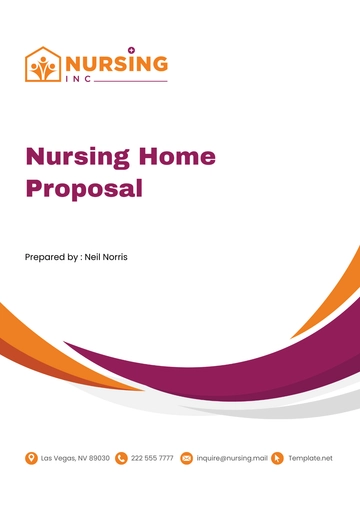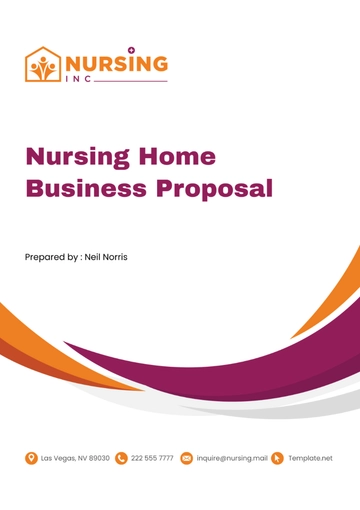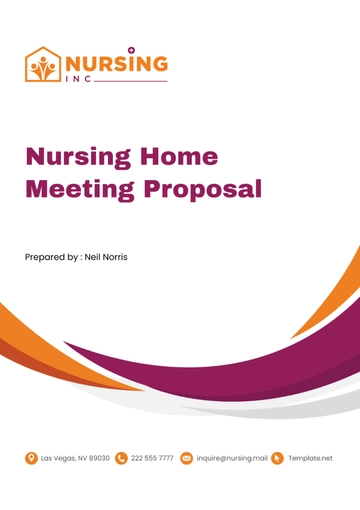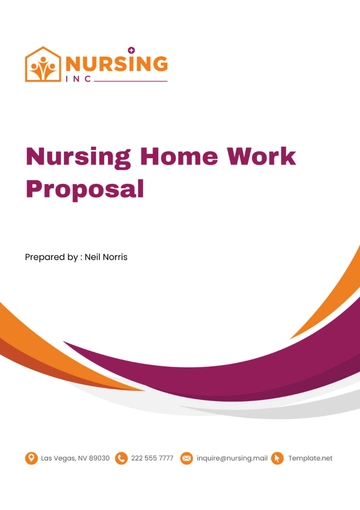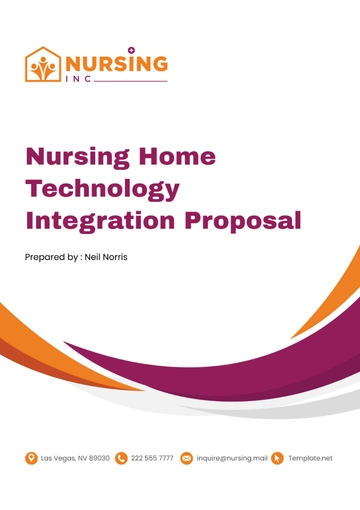Free Nursing Home Technology Integration Proposal
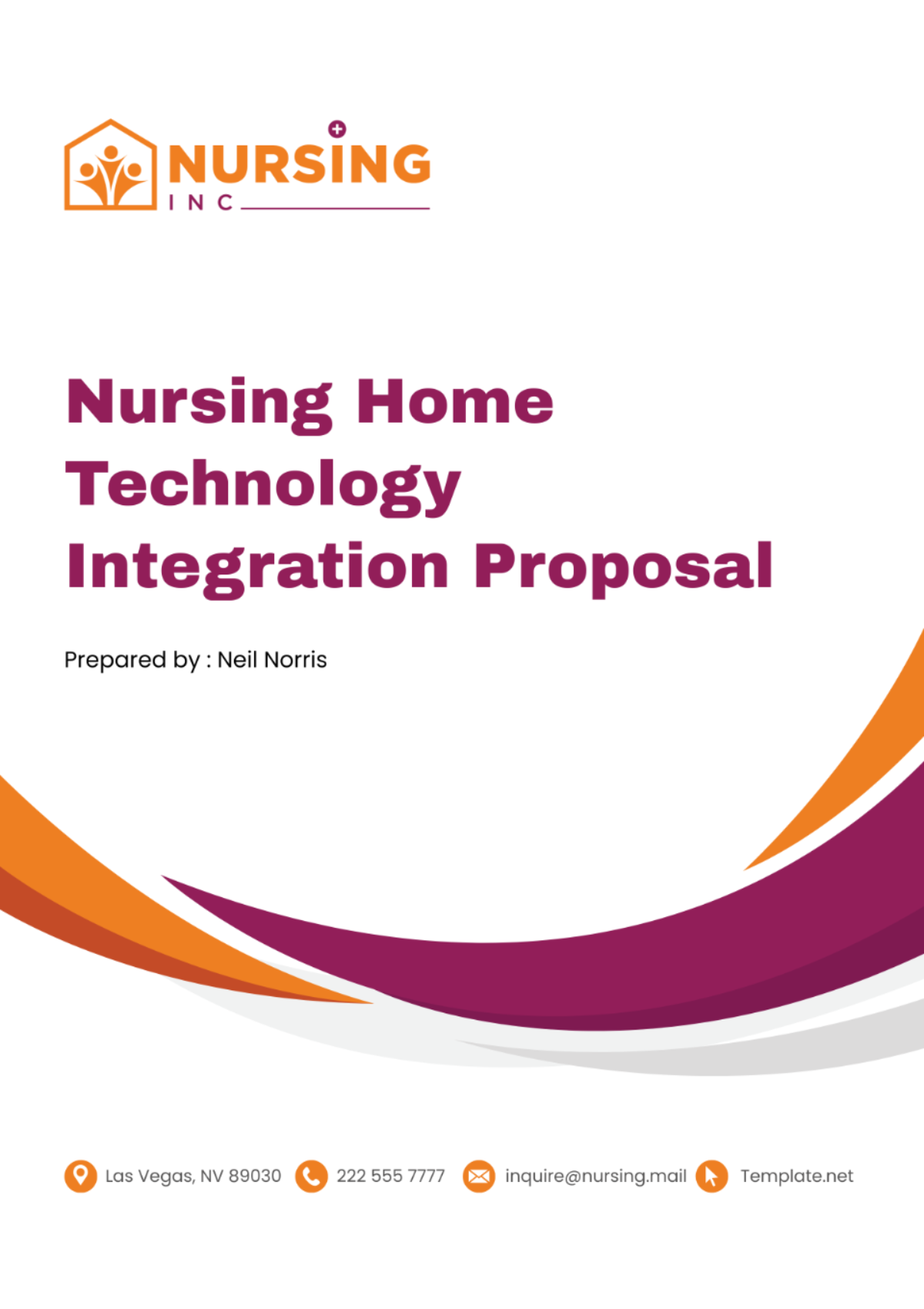
I. Executive Summary
The Nursing Home Technology Integration Proposal of [Your Company Name] presents a comprehensive plan to revolutionize the care landscape in nursing homes through the integration of advanced technology systems. The proposal outlines a phased approach to technology integration, starting with a preliminary assessment of existing systems and needs, followed by careful planning and design, execution, and ongoing monitoring and evaluation.
The proposed technology solutions include digital communication systems, automated health monitoring systems, efficient data management systems, smart home technologies, and virtual reality technologies. These technologies are expected to enhance healthcare delivery, improve communication networks, streamline operational processes, and increase resident satisfaction.
The proposal also outlines a detailed budget, providing a transparent estimate of the costs associated with the technology integration. The total estimated cost of the project is $110,000, representing a strategic investment in the future of the nursing home.
Potential risks, such as resistance to change, data security threats, and technology failures, have been identified, and robust mitigation strategies have been proposed. These include intensive staff training, robust data security measures, and the establishment of a dedicated IT support team.
In conclusion, the proposal provides a clear and structured roadmap for integrating technology into nursing homes. By following this approach, nursing homes can enhance their service delivery, improve operational efficiency, and ultimately provide a higher quality of care for their residents. The proposal represents a significant opportunity for nursing homes to leverage technology to meet the evolving needs of their residents and stay at the forefront of the care industry.
II. Specific Objectives
The objective of this project is to revolutionize the nursing home care landscape. We aim to achieve this through the following specific objectives:
A. Optimizing Care Delivery
Personalized Care Plans: We aim to develop personalized care plans for each resident, taking into account their unique health conditions and needs. This approach ensures that each resident receives the most appropriate care for their individual situation.
Efficient Resource Allocation: We plan to use predictive analytics to anticipate residents’ needs and allocate resources efficiently. This will help to ensure that each resident receives the care they need when they need it.
Quality Assurance: We will implement technology solutions that ensure the highest standards of care are consistently met. This will help to maintain the trust and confidence of residents and their families in our services.
Continuous Improvement: We will use data-driven insights to continuously improve care delivery processes. This will help us to continually enhance the quality of care we provide.
Regulatory Compliance: We will ensure all care delivery processes are in compliance with relevant regulations and standards. This will help to maintain our reputation as a trustworthy and reliable provider of care.
B. Enhancing Communication
Resident-Caretaker Communication: We will implement communication systems that allow residents and caretakers to communicate effectively and effortlessly. This will help to ensure that residents’ needs are met promptly and accurately.
Family Communication: We will provide platforms for family members to stay informed about their loved one’s health and wellbeing. This will help to reassure families that their loved ones are receiving the best possible care.
Interdepartmental Communication: We will facilitate seamless communication between different departments within the nursing home to ensure coordinated care. This will help to ensure that all aspects of a resident’s care are well-coordinated.
Emergency Communication: We will establish robust systems for quick and effective communication during emergencies. This will help to ensure that we can respond promptly and effectively to any emergencies that may arise.
C. Improving Resource Management
Inventory Management: We will implement technology solutions for tracking and managing inventory to ensure necessary supplies are always available. This will help to prevent shortages and ensure that we can provide the necessary care at all times.
Staff Scheduling: We will use advanced scheduling systems to optimize staff shifts and ensure adequate coverage at all times. This will help to ensure that residents receive the care they need, when they need it.
Budget Management: We will leverage technology to track expenses and manage the nursing home’s budget effectively. This will help to ensure that we can continue to provide high-quality care while maintaining financial sustainability.
Maintenance Management: We will use predictive maintenance tools to manage and maintain equipment and facilities. This will help to ensure that our facilities and equipment are always in good working order.
Data Management: We will implement robust data management systems to securely store and easily access resident records and other important information. This will help to ensure that we can provide personalized care based on accurate and up-to-date information.
III. Methodology
Our approach will involve a phased rollout of technology integration:
A. Preliminary Assessment
Existing Systems Evaluation: A comprehensive evaluation of the existing systems in the nursing home will be conducted. This will include:
1.1. Infrastructure Assessment: An in-depth assessment of the current IT infrastructure will be carried out to determine its capacity to support the proposed technology integration. This will help identify any necessary upgrades or enhancements.
1.2. Systems Usage Analysis: An analysis of how current systems are being used will be performed. This will help understand the strengths and weaknesses of these systems and identify opportunities for improvement.
Needs Assessment: The needs and challenges of the nursing home that can be addressed through technology integration will be identified. This will involve:
2.1. Stakeholder Interviews: Interviews with staff, residents, and their families will be conducted to understand their needs and expectations.
2.2. Process Analysis: Current processes will be analyzed to identify inefficiencies and areas where technology could improve outcomes.
Stakeholder Consultation: Consultations with key stakeholders, including staff, residents, and their families, will be held to understand their needs and expectations. This will involve:
3.1. Feedback Sessions: Feedback sessions with stakeholders will be held to understand their experiences with current systems and their expectations for the proposed technology integration.
3.2. Expectations Management: Clear communication about what stakeholders can expect from the technology integration will be provided, addressing any concerns or misconceptions they may have.
B. Planning and Design
Technology Selection: Based on the findings from the preliminary assessment, the most suitable technologies for integration will be selected. This will involve:
1.1. Vendor Evaluation: Potential vendors will be evaluated based on their technology offerings, support services, and cost-effectiveness.
1.2. Technology Testing: Potential technologies will be tested to ensure they meet our needs and are compatible with our existing systems.
System Design: A technology integration blueprint that outlines how the selected technologies will be integrated into the existing systems will be designed. This will involve:
2.1. System Architecture Design: The architecture of the integrated system will be designed, ensuring it is scalable, secure, and robust.
2.2. User Interface Design: User-friendly interfaces will be designed that make it easy for staff and residents to interact with the new technologies.
Risk Assessment: Potential risks and challenges that could arise during the implementation will be identified and strategies to mitigate them will be developed. This will involve:
3.1. Risk Identification: Potential risks associated with the technology integration, such as technical issues, user resistance, and cost overruns, will be identified.
3.2. Risk Mitigation Plan: Strategies to mitigate these risks, such as providing adequate training, setting realistic timelines, and allocating sufficient resources, will be developed.
C. Execution
System Installation: The selected technologies will be installed as per the technology integration blueprint. This will involve:
1.1. Hardware Installation: Any necessary hardware, such as servers, networking equipment, and user devices, will be installed.
1.2. Software Installation: The necessary software will be installed and configured, ensuring it is properly integrated with our existing systems.
Staff Training: Comprehensive training for staff will be conducted to ensure they can effectively use the new technologies. This will involve:
2.1. Training Sessions: Training sessions will be held to teach staff how to use the new technologies, covering both basic usage and advanced features.
2.2. Support Materials: Support materials, such as user manuals and online resources, will be provided to help staff learn at their own pace.
Pilot Testing: Pilot testing will be conducted to identify and address any issues before full-scale implementation. This will involve:
3.1. Test Scenarios: Test scenarios will be created to simulate real-world usage of the new technologies, allowing us to identify any issues or areas for improvement.
3.2. Feedback Collection: Feedback from the pilot users will be collected and used to refine the system before full-scale implementation.
Full-Scale Implementation: The technology integration will be rolled out across the entire nursing home. This will involve:
4.1. System Deployment: The new technologies will be deployed across the nursing home, ensuring all staff and residents have access to them.
4.2. Transition Support: Support during the transition period will be provided to help staff and residents adjust to the new technologies.
Feedback Collection: Feedback from staff and residents will be collected to identify any areas for improvement. This will involve:
5.1. Feedback Surveys: Surveys will be conducted to collect feedback from staff and residents about their experiences with the new technologies.
5.2. Feedback Analysis: The feedback will be analyzed to identify trends and areas for improvement.
System Optimization: Based on the feedback, necessary adjustments to optimize the system will be made. This will involve:
6.1. System Updates: The system will be updated to address any issues identified through feedback and to add new features or enhancements.
6.2. Continuous Improvement: The system will be continuously monitored and improvements will be made as necessary to ensure it continues to meet the needs of staff and residents.
D. Monitoring & Evaluation
Performance Monitoring: The performance of the new technologies will be continuously monitored to ensure they are functioning as expected. This will involve:
1.1. System Monitoring: Monitoring tools will be used to track the performance of the new technologies, identifying any issues or areas for improvement.
1.2. Performance Reporting: Regular reports on the performance of the new technologies will be provided to keep all stakeholders informed.
Impact Evaluation: The impact of the technology integration on care delivery, communication, and resource management will be evaluated. This will involve:
2.1. Outcome Measurement: Outcomes, such as improvements in care quality, efficiency gains, and resident satisfaction, will be measured to evaluate the impact of the technology integration.
2.2. Impact Reporting: Regular reports on the impact of the technology integration will be provided to keep all stakeholders informed.
Feedback Collection: Regular feedback from staff, residents, and their families will be collected to identify any areas for improvement. This will involve:
3.1. Feedback Surveys: Regular surveys will be conducted to collect feedback from staff, residents, and their families.
3.2. Feedback Analysis: The feedback will be analyzed to identify trends and areas for improvement.
System Updates: The systems will be regularly updated to incorporate new features and improvements. This will involve:
4.1. System Maintenance: Regular maintenance and updates of the systems will be carried out to ensure they continue to function optimally.
4.2. New Feature Integration: New features and improvements based on feedback and technological advancements will be integrated.
Continuous Learning: The insights gained from the monitoring and evaluation will be used to continuously improve the technology integration. This will involve:
5.1. Lessons Learned: Lessons learned from the technology integration will be documented and used to inform future projects.
5.2. Best Practice Development: Best practices for technology integration in nursing homes will be developed based on our experiences.
Reporting: Regular reports on the progress and impact of the technology integration will be provided to all stakeholders. This will involve:
6.1. Progress Reports: Regular updates on the progress of the technology integration, including any challenges encountered and how these were addressed, will be provided.
6.2. Impact Reports: Reports on the impact of the technology integration, including improvements in care delivery, communication, and resource management, will be provided.
IV. Proposed Solution
The proposed solution involves the integration of advanced technology systems into the nursing home’s operations to enhance service delivery and improve overall efficiency.
A. Technology Solutions for Nursing Homes
Digital Communication Systems: Implementing digital communication systems can facilitate seamless communication between residents, staff, and family members. These systems can include video conferencing tools, instant messaging platforms, and digital notice boards. The use of these systems can significantly improve the speed and efficiency of communication, leading to better coordination of care and increased satisfaction among residents and their families.
Automated Health Monitoring Systems: Automated health monitoring systems can provide continuous monitoring of residents’ health conditions. These systems can include wearable devices that monitor vital signs, smart beds that track sleep patterns, and automated medication dispensers. By providing real-time, accurate health data, these systems can enable early detection of health issues and timely intervention, thereby improving the quality of care.
Data Management Systems: Efficient data management systems can streamline the process of record-keeping, making it easier to track residents’ health progress, manage staff schedules, and maintain inventory records. By automating these tasks, staff can spend more time on direct care activities, leading to improved resident outcomes.
Smart Home Technologies: Integrating smart home technologies can enhance the living environment for residents. These technologies can include automated lighting systems, voice-activated devices, and smart thermostats. By creating a more comfortable and convenient living environment, these technologies can contribute to improved quality of life for residents.
Virtual Reality (VR) Technologies: VR technologies can provide recreational and therapeutic benefits for residents. For example, VR can be used to provide virtual travel experiences or cognitive therapy for residents. By offering engaging and stimulating activities, these technologies can contribute to improved mental well-being for residents.
B. Implementation Strategy
Phased Implementation: The technology integration will be carried out in phases to ensure minimal disruption to the nursing home’s operations. Each phase will focus on a specific aspect of the technology integration, starting with the most critical systems. This approach allows for careful monitoring of each phase and timely resolution of any issues that may arise.
Staff Training: Comprehensive training programs will be conducted to equip the staff with the necessary skills to use the new technologies. This will include hands-on training sessions, online tutorials, and continuous support. By ensuring that staff are comfortable and proficient with the new technologies, we can ensure smooth operation and maximum benefit from the technology integration.
Resident Orientation: Residents will be oriented to the new technologies through demonstrations and guided practice sessions. This will help them understand how to use the technologies and how they will benefit from them. By involving residents in the process, we can ensure that the technologies are user-friendly and meet the needs of the residents.
Continuous Monitoring and Evaluation: The performance of the new technologies will be continuously monitored and evaluated to ensure they are meeting the intended objectives. Feedback from staff and residents will be used to make necessary adjustments and improvements. This ongoing evaluation process will ensure that the technology integration continues to deliver value and meet the evolving needs of the nursing home.
Future Upgrades and Expansions: The technology integration plan will include provisions for future upgrades and expansions. This will ensure that the nursing home can continue to benefit from technological advancements in the future. By planning for the future, we can ensure that the nursing home remains at the forefront of technology use in healthcare.
V. Timeline
The implementation process is divided into several phases, each with its own estimated timeframe. The following table provides an overview of these phases and their respective timeframes:
Phase | Estimated Time Frame |
|---|---|
Preliminary Assessment | 1-2 months |
Planning and Design | 2-3 months |
Execution | 6-8 months |
Monitoring & Evaluation | Ongoing |
The Preliminary Assessment phase, estimated to take 1-2 months, involves a comprehensive evaluation of the existing systems in the nursing home. This phase is crucial for understanding the current state of operations and identifying areas where technology can be integrated to enhance efficiency and improve care.
The Planning and Design phase, which is expected to last 2-3 months, involves designing a technology integration blueprint based on the findings from the preliminary assessment. This phase is critical for ensuring that the proposed technology solutions align with the needs and objectives of the nursing home.
The Execution phase, estimated to take 6-8 months, involves the actual implementation of the technology blend as per the blueprint. This phase is where the plans come to life, with the selected technologies being installed and integrated into the nursing home’s operations.
Finally, the Monitoring & Evaluation phase is an ongoing process that starts as soon as the execution phase begins. This phase involves continuously monitoring the performance of the new technologies and evaluating their impact on care delivery, communication, and resource management.
Each phase of this process plays a crucial role in ensuring the successful integration of technology into the nursing home’s operations. The estimated timeframes provide a roadmap for the implementation process, helping stakeholders understand when they can expect to see results.
This phased approach allows for flexibility and adaptability. If challenges or obstacles are encountered during one phase, adjustments can be made before moving on to the next phase. This ensures that the technology integration process is responsive to the unique needs and circumstances of the nursing home. By following this approach, the nursing home can enhance their service delivery, improve operational efficiency, and ultimately provide a higher quality of care for their residents.
VI. Budget
Here, we will provide a detailed breakdown of the estimated costs associated with each aspect of the project. The following chart and table present the budget:
Item | Estimated Cost |
|---|---|
Hardware (Communication devices, sensors) | $50,000 |
Software (Data management system, cloud services) | $30,000 |
Implementation (Installation, staff training) | $20,000 |
Contingency and Unforeseen Expenses | $10,000 |
Total | $110,000 |
The budget outlined in this proposal provides a comprehensive and transparent estimate of the costs associated with the proposed technology integration. It represents a strategic investment in the future of the nursing home, with the potential to deliver significant benefits in terms of enhanced service delivery, improved operational efficiency, and improved resident wellbeing.
The Hardware budget, estimated at $50,000, covers the cost of communication devices and sensors. These are essential components of the technology integration, enabling effective communication and health monitoring. The investment in high-quality hardware is crucial as it forms the backbone of the integrated technology systems. It ensures reliable performance and longevity, thereby providing value for money in the long term.
The Software budget, estimated at $30,000, includes the cost of the data management system and cloud services. Software is the driving force behind the technology integration, enabling efficient data management and secure storage. Investing in robust and reliable software solutions ensures the smooth operation of the integrated systems and safeguards the valuable data of the nursing home.
The Implementation budget, estimated at $20,000, covers the cost of installation and staff training. Proper installation is crucial to ensure that the new technologies function correctly and are seamlessly integrated into the existing systems. Staff training is equally important to ensure that the staff can effectively use the new technologies. This investment in implementation ensures that the transition to the new systems is smooth and successful.
The Contingency and Unforeseen Expenses budget, estimated at $10,000, is set aside to cover any unexpected costs that may arise during the project. This is a prudent measure to ensure that the project can continue smoothly even if unforeseen expenses occur.
The total estimated cost of the project is $110,000. This represents a significant investment in the future of the nursing home, with the potential to greatly enhance service delivery, improve operational efficiency, and improve resident wellbeing.
The detailed breakdown of the budget allows for transparency and accountability. Each budget item is clearly defined, allowing stakeholders to see exactly where the funds are being allocated. This can help build trust and confidence in the project, as stakeholders can see that the funds are being used responsibly and effectively.
VII. Benefits and Impact
The implementation of this proposal will result in significant benefits and impact on the nursing home’s operations and service delivery:
A. Enhanced Healthcare Delivery
Improved Health Monitoring: The integration of automated health monitoring systems will enable continuous and accurate monitoring of residents’ health conditions. This will allow for early detection of potential health issues and timely intervention, thereby improving the overall quality of healthcare delivery.
Personalized Care: The use of digital communication systems and data management systems will enable the provision of personalized care to each resident, taking into account their unique health conditions and needs. This will ensure that each resident receives the most appropriate care for their individual situation.
Efficient Resource Management: The use of technology will streamline various operational processes, leading to more efficient resource management. This will allow the nursing home to provide better care to residents while also reducing operational costs.
Increased Patient Satisfaction: The enhanced healthcare delivery, improved communication, and personalized care will lead to increased satisfaction among residents and their families. This will improve the reputation of the nursing home and could potentially lead to an increase in admissions.
B. Improved Communication Networks
Seamless Communication: The implementation of digital communication systems will facilitate seamless communication between residents, staff, and family members. This will improve coordination of care and ensure that residents’ needs are met promptly and accurately.
Improved Coordination of Care: The improved communication networks will lead to better coordination of care among the nursing home staff. This will ensure that all aspects of a resident’s care are well-coordinated, leading to better health outcomes for residents.
Increased Engagement: The digital communication systems will also provide opportunities for residents to engage with others and participate in activities, contributing to a sense of community within the nursing home.
VIII. Risks and Mitigation Strategies
While the benefits of technology integration are significant, it’s also important to consider potential risks and develop strategies to mitigate them:
A. Resistance to Change
Staff Resistance: Staff members may resist the changes brought about by technology integration due to fear of the unknown or lack of confidence in using new technologies. To mitigate this risk, intensive staff training will be provided to equip staff with the necessary skills to use the new technologies.
Resident Resistance: Residents may also resist the changes, particularly if they are not comfortable with technology. To address this, residents will be oriented to the new technologies through demonstrations and guided practice sessions.
Family Resistance: Family members may resist the changes due to concerns about the safety or effectiveness of the new technologies. To mitigate this risk, regular communication with family members will be maintained to address their concerns and keep them informed about the benefits of the technology integration.
B. Data Security Threats
Data Breaches: The integration of technology increases the risk of data breaches, which could compromise the privacy and security of residents’ health information. To mitigate this risk, robust data security measures will be implemented, including encryption, secure access controls, and regular security audits.
Data Loss: There is also a risk of data loss due to technical issues or system failures. To address this, regular data backups will be conducted and a disaster recovery plan will be developed.
Data Misuse: There is a risk that data could be misused if it falls into the wrong hands. To mitigate this risk, strict data access controls will be implemented and staff will be trained on data privacy and security protocols.
C. Technology Failures
System Downtime: System downtime due to technical issues or failures could disrupt the nursing home’s operations and negatively impact care delivery. To mitigate this risk, a dedicated IT support team will be in place to quickly resolve any technical issues and minimize downtime.
Technology Obsolescence: There is also a risk that the technology could become obsolete over time. To address this, the technology systems will be regularly updated and provisions will be made for future upgrades and expansions.
User Errors: There is a risk that user errors could lead to system failures or data errors. To mitigate this risk, comprehensive user training will be provided and user-friendly interfaces will be designed to minimize the likelihood of user errors.
IX. Conclusion
This proposal by [Your Company Name] stands to significantly enhance services in nursing homes through the thoughtful integration of technology. The proposed technology integration, as outlined in this proposal, is designed to address the unique needs and challenges of nursing homes. It involves a comprehensive approach that includes the evaluation of existing systems, the selection and design of suitable technologies, and a phased implementation strategy. This approach ensures that the technology integration is tailored to the specific context of the nursing home and is implemented in a way that minimizes disruption and maximizes benefits.
Furthermore, the proposal also outlines the expected benefits and potential risks associated with the technology integration and provides strategies to mitigate these risks. The benefits are wide-ranging and include enhanced healthcare delivery, improved communication networks, better decision-making through efficient data management, and increased patient satisfaction. The potential risks, such as resistance to change, data security threats, and technology failures, are addressed through comprehensive mitigation strategies. This ensures that the technology integration is not only beneficial but also safe and secure. Overall, this proposal provides a clear and comprehensive roadmap for the successful integration of technology into nursing homes, with the potential to significantly enhance the quality of care and improve the lives of residents.
- 100% Customizable, free editor
- Access 1 Million+ Templates, photo’s & graphics
- Download or share as a template
- Click and replace photos, graphics, text, backgrounds
- Resize, crop, AI write & more
- Access advanced editor
Say hello to the Nursing Home Technology Integration Proposal Template from Template.net! This customizable tool is designed to help create compelling proposals for integrating technology into nursing home operations. With the AI Editor Tool, this template can be edited to suit specific proposal needs! Grab your editable copy right away!
You may also like
- Business Proposal
- Research Proposal
- Proposal Request
- Project Proposal
- Grant Proposal
- Photography Proposal
- Job Proposal
- Budget Proposal
- Marketing Proposal
- Branding Proposal
- Advertising Proposal
- Sales Proposal
- Startup Proposal
- Event Proposal
- Creative Proposal
- Restaurant Proposal
- Blank Proposal
- One Page Proposal
- Proposal Report
- IT Proposal
- Non Profit Proposal
- Training Proposal
- Construction Proposal
- School Proposal
- Cleaning Proposal
- Contract Proposal
- HR Proposal
- Travel Agency Proposal
- Small Business Proposal
- Investment Proposal
- Bid Proposal
- Retail Business Proposal
- Sponsorship Proposal
- Academic Proposal
- Partnership Proposal
- Work Proposal
- Agency Proposal
- University Proposal
- Accounting Proposal
- Real Estate Proposal
- Hotel Proposal
- Product Proposal
- Advertising Agency Proposal
- Development Proposal
- Loan Proposal
- Website Proposal
- Nursing Home Proposal
- Financial Proposal
- Salon Proposal
- Freelancer Proposal
- Funding Proposal
- Work from Home Proposal
- Company Proposal
- Consulting Proposal
- Educational Proposal
- Construction Bid Proposal
- Interior Design Proposal
- New Product Proposal
- Sports Proposal
- Corporate Proposal
- Food Proposal
- Property Proposal
- Maintenance Proposal
- Purchase Proposal
- Rental Proposal
- Recruitment Proposal
- Social Media Proposal
- Travel Proposal
- Trip Proposal
- Software Proposal
- Conference Proposal
- Graphic Design Proposal
- Law Firm Proposal
- Medical Proposal
- Music Proposal
- Pricing Proposal
- SEO Proposal
- Strategy Proposal
- Technical Proposal
- Coaching Proposal
- Ecommerce Proposal
- Fundraising Proposal
- Landscaping Proposal
- Charity Proposal
- Contractor Proposal
- Exhibition Proposal
- Art Proposal
- Mobile Proposal
- Equipment Proposal
- Student Proposal
- Engineering Proposal
- Business Proposal
